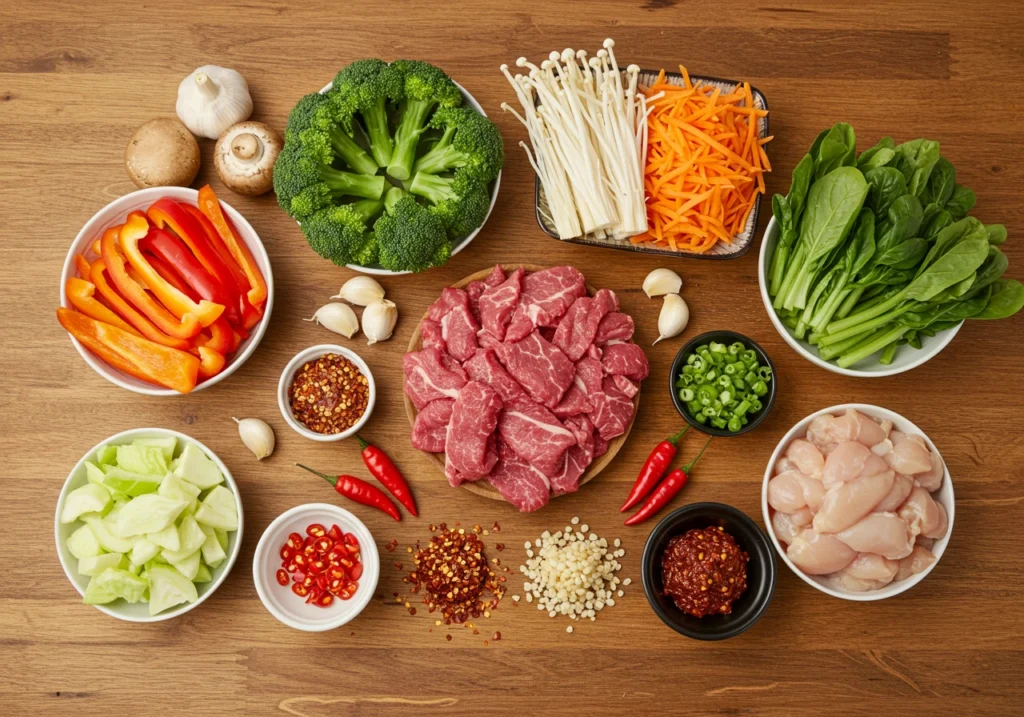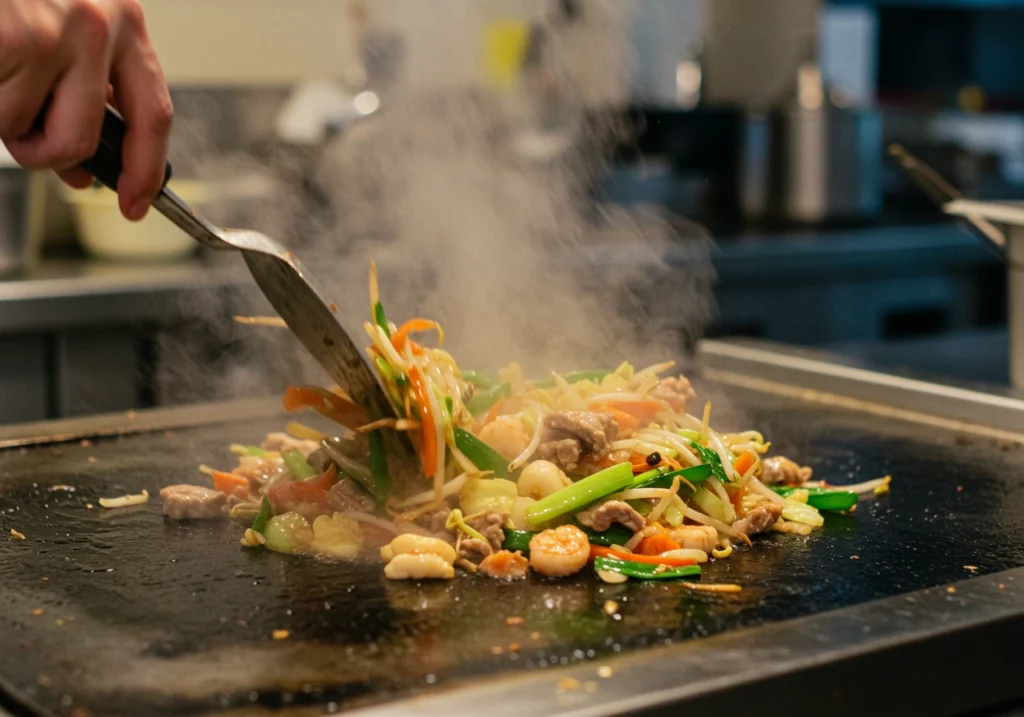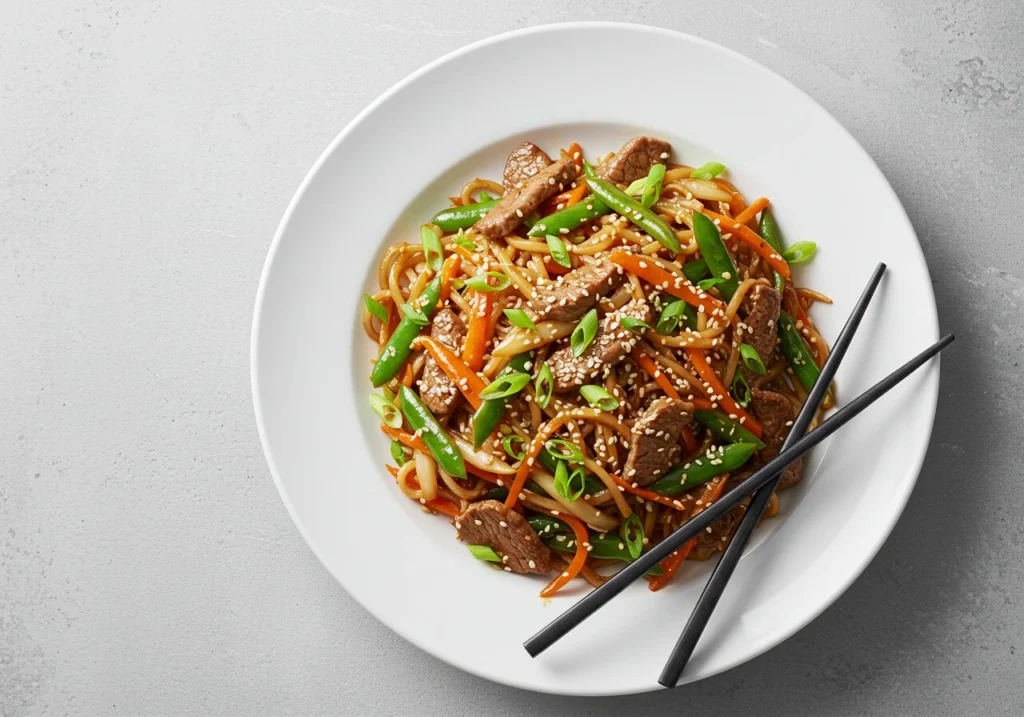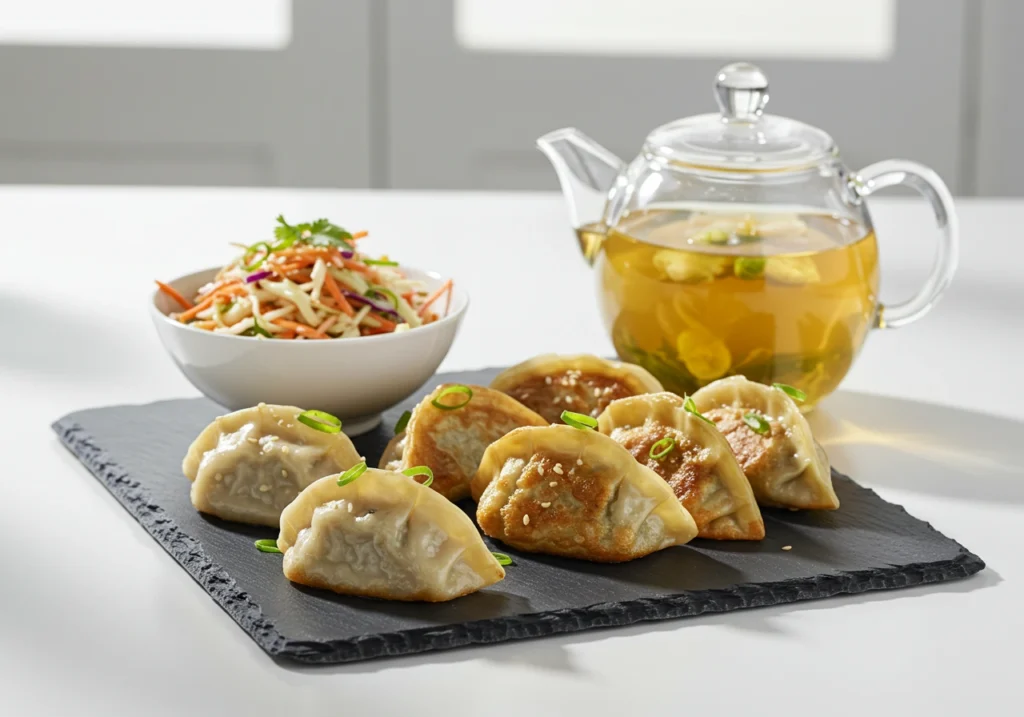Article Introduction
Ah, Mongolian BBQ! It’s bold, fiery, and satisfying on every level. But here’s the twist—it’s not actually from Mongolia. Yet, this East-meets-West dish, often cooked on a flat-top grill with sizzling sauces and vibrant veggies, is a staple in many households across the globe. And guess what? You don’t need a fancy grill or professional wok skills to master it at home.
This article breaks down an authentic Mongolian BBQ recipe into digestible parts, using simple techniques and pantry staples. I’ve personally cooked this at home, made some rookie mistakes, found some surprising shortcuts, and I’m sharing it all with you.
So, grab your spatula, roll up your sleeves, and let’s stir-fry our way into culinary glory. Up first, let’s understand exactly what Mongolian BBQ is—and isn’t.
Part 1: Understanding Mongolian BBQ – It’s Not Really Mongolian!
What Is Mongolian BBQ? A Delicious Identity Crisis
Mongolian BBQ is a wildly popular dish that sounds like it hails from Mongolia. Spoiler alert: it doesn’t. It was actually born in Taiwan during the 1950s, dreamed up by street vendors trying to combine the robust flavors of stir-fry with a theatrical cooking style that wowed diners. And wow, did it work!
This dish isn’t cooked low and slow like your typical barbecue either. Instead, it’s a high-heat dance of thin-sliced meats, veggies, and noodles, tossed together on a screaming-hot griddle. Think: sizzling stir-fry on steroids.
The misnomer stuck, though, and now “Mongolian BBQ” conjures up visions of buffet bars and bubbling sauces. And while the restaurant version has its own charm, making it at home means total control—over spice, ingredients, and healthiness.
Is It Actually BBQ? Not Quite. But That’s the Beauty
Barbecue usually means open flames, long hours, and smoky flavors. Mongolian BBQ laughs in the face of that rulebook. This dish is all about speed, simplicity, and instant gratification. No smokers. No marinades soaking overnight. Just a hot pan, fresh ingredients, and bold flavors that come together in minutes.
So, if you’re picturing a backyard BBQ with coals and ribs—think again. This is a different beast. And it’s one you’re gonna want to tame in your own kitchen.
The Secret Sauce (Literally and Figuratively)
The real charm lies in the sauce. It’s that sticky, sweet, garlicky goodness that clings to each bite. A balance of soy, garlic, brown sugar, and sometimes hoisin or sesame oil—it’s a blast of umami that makes your taste buds sit up and salute.
And don’t worry—I’ll walk you through crafting that magical sauce in Part 4.
But before that, it’s essential to gear up. Because a Mongolian BBQ recipe is only as good as the ingredients you start with. Next, we’ll go over every noodle, veggie, and protein you might want to toss into your sizzling wok.
Part 2: Understanding Mongolian BBQ – It’s Not Really Mongolian!
Despite what its name suggests, Mongolian BBQ didn’t sprout from the grasslands of Mongolia. In fact, it first sizzled to life on the vibrant streets of Taiwan during the 1950s. A crafty invention of local food vendors, it was a theatrical, crowd-pleasing spin on traditional stir-fry—designed more for the “wow” factor than for historical accuracy. So no, it’s not Mongolian in origin, but it absolutely embodies the energetic fusion of East Asian flavors.
One of the reasons this dish became such a runaway hit is its interactive style. Restaurants, particularly in the West, caught onto this and ran with it. Enter the all-you-can-eat Mongolian BBQ buffet bars. There, you choose your ingredients—noodles, meats, sauces, veggies—and watch a chef stir-fry them on a large, round, screaming-hot griddle. Smoke, sizzle, and savory aromas create a dining experience that’s as much performance as it is meal.

At home, though, things are a tad different. While you might not have a circular teppanyaki grill in your kitchen, you can absolutely mimic the experience using a wok, skillet, or flat griddle. With the right ingredients and a flavorful sauce, the homemade version can even taste better—plus, you get full control over ingredients, oil levels, and spice.
So why is this dish so beloved in the West? Simple: it’s fast, customizable, and downright addictive. It’s a weeknight dinner hero that feels like a Saturday night splurge.
Is Mongolian BBQ Actually Barbecue?
Well, technically—nope. Traditional barbecue implies slow cooking over an open flame. Mongolian BBQ, however, is more of a turbo-charged stir-fry cooked on a flat metal griddle at blazing temperatures. There’s no smoke, no charcoal, and definitely no long hours tending to a pit. Instead, it’s a quick flash-cook method that caramelizes sauce, crisps meat, and keeps veggies tender yet crisp.
So while it’s called “barbecue,” think of it as a branding misfire that somehow stuck—and we’re not mad about it. In fact, once you’ve tried making it at home, you might just toss your grill aside… or at least give it a break.
Part 3: Key Ingredients for the Perfect Mongolian BBQ at Home
One of the absolute joys of whipping up a Mongolian BBQ recipe at home is the flexibility. You’re not locked into a single protein or veggie combo—you can personalize every bite to match your cravings. But if you’re wondering where to start, I’ve got you covered with all the must-haves and a few tasty suggestions.
Essential Proteins
Let’s kick it off with the star of the show—protein. Traditionally, Mongolian BBQ leans toward beef, especially cuts like flank steak or sirloin. These are ideal because they’re lean, flavorful, and cook lightning-fast when sliced thin.
If beef isn’t your thing, you’ve got delicious options. Thin-cut chicken breast or thigh, shrimp, or even tofu work wonderfully. Tofu especially soaks up sauce like a champ, making it perfect for vegetarians or those leaning plant-based. Just be sure to press it well before stir-frying for that crave-worthy, crispy edge.
Vegetables That Stir-Fry Well
Colorful, crisp, and packed with nutrients—veggies are essential for both flavor and texture. The best stir-fry choices are:
- Bell peppers (any color)
- Shredded cabbage
- Julienned carrots
- Sliced onions
- Mushrooms (shiitake or button)
These vegetables not only add a pop of color to your dish, but they also hold up well to high-heat cooking.
Noodles and Rice Options
While the restaurant version often lets you pick, you can do the same at home. Popular base options include:
- Udon noodles: thick and chewy
- Rice noodles: light and gluten-free
- Jasmine rice: a fluffy, fragrant alternative
Whatever your choice, make sure it’s cooked and cooled before tossing it into the stir-fry. That way, it won’t turn to mush under heat.
The Famous Mongolian BBQ Sauce
Let’s be honest—the sauce makes or breaks this dish. A proper Mongolian BBQ sauce is equal parts sweet, savory, and garlicky. To make your own, you’ll need:
- Soy sauce (light for less sodium)
- Garlic, minced
- Fresh ginger, grated
- Brown sugar for that sticky sweetness
- A splash of hoisin sauce for depth
Part 4: Step-by-Step Mongolian BBQ Recipe – Tried and Loved!
Here comes the fun part! Once you’ve gathered your fresh veggies, proteins, and pantry staples, it’s time to bring your Mongolian BBQ recipe to life. I recently cooked this dish in my kitchen, and let me tell you—it was an aromatic, sizzling, flavor-packed adventure I’ll be repeating often.
Let’s break it down step by step so you can create this stir-fry sensation like a seasoned chef.

Preparing the Sauce
Your sauce is the flavor hero—so don’t cut corners here. In a small bowl or saucepan, mix the following:
- ½ cup of low-sodium soy sauce
- 3 tablespoons of brown sugar
- 2 tablespoons hoisin sauce
- 1 tablespoon grated ginger
- 2-3 cloves of garlic, minced
- Optional: a splash of sesame oil or a pinch of red pepper flakes for heat
Simmer the mixture on low heat for 3–5 minutes until it slightly thickens. You’re looking for a glossy, velvety texture that’ll cling to your ingredients like a dream. The secret? A fine balance between sweet and savory—taste and tweak until it sings.
Marinating the Meat
If you’re using beef, chicken, or shrimp, thinly slice it across the grain (for beef) or into strips (for poultry). The thinner, the better—it cooks lightning fast and soaks up the marinade like a sponge.
Toss the meat with 2–3 tablespoons of your sauce and let it rest for 15–30 minutes. You can go longer (up to 24 hours) in the fridge if prepping ahead. For tofu, gently press out water, cut into cubes, and marinate for about 20 minutes.
Cooking on a Griddle or Wok
Grab a wok, cast-iron skillet, or flat-top griddle. Heat it over high heat until it’s smoking hot. Add a drizzle of neutral oil (like canola or avocado), and sear your meat in batches—crowding the pan will steam it instead of searing. Each batch should take no more than 2–3 minutes.
Keep it moving! Mongolian BBQ is about quick, high-heat cooking. Think fast hands, big flavor.
Stir-Frying Veggies
Once your protein is cooked and set aside, toss in your chopped veggies—starting with the firmest (like carrots) and adding softer ones (like bell peppers or cabbage) later.
Don’t overcook! You want your veggies to stay bright, slightly crisp, and full of texture. Stir-fry for 2–4 minutes max, tossing often to coat them in that smoky flavor from the pan.
Combining with Noodles or Rice
Now bring everything together: protein, veggies, and your pre-cooked udon, rice noodles, or steamed jasmine rice. Add a few more spoons of sauce and toss well over medium-high heat until everything is evenly coated and heated through.
Finish it off with green onions, sesame seeds, or a dash of chili oil if you like heat. I even tried it with a handful of crushed peanuts for a nutty crunch—game changer!
Part 5: My Pro Tips After Making Mongolian BBQ Myself
After giving this Mongolian BBQ recipe a whirl in my own kitchen, I’ve learned a few golden rules—some through trial and error (oops), and others from sheer curiosity. Trust me, these little tweaks and tips can turn a decent dish into a next-level stir-fry experience. Here’s what I wish I’d known from the start.
Best Cuts of Meat
When it comes to beef, not all cuts are created equal. If you want that juicy, melt-in-your-mouth experience, go for flank steak or sirloin. These cuts are lean, tender, and quick to cook. But—and this is key—slice them super thin against the grain. Doing so shortens the muscle fibers, making the meat incredibly tender once it hits the hot pan.
For chicken lovers, boneless thighs offer more flavor than breast meat and stay moist even on high heat. And if you’re going meatless, extra firm tofu, well-pressed and cubed, holds up beautifully and soaks up every drop of that flavorful sauce.
Managing Heat on Home Equipment
Recreating that high-heat restaurant stir-fry vibe isn’t always easy with standard stovetops. But don’t worry—you can fake it pretty well. Use a cast-iron skillet or carbon steel wok and let it preheat until it’s just shy of smoking.
Keep batches small so you don’t crowd the pan. If it’s overloaded, you’ll steam the ingredients instead of searing them. And stir constantly—this is called stir-fry for a reason, right?

Ingredient Prep for Quick Cooking
This dish cooks fast. Like, really fast. So mise en place (a fancy way of saying “prep everything ahead of time”) is your best friend.
Slice all proteins, chop veggies, cook and cool your noodles, and have your sauce ready before even turning on the stove. Once that heat cranks up, you won’t have time to fumble.
Part 6: Recipe Variations You Should Try
One of the coolest things about a Mongolian BBQ recipe is how flexible it is. Whether you’re plant-based, cutting carbs, or crave a fiery kick, you can tailor this dish to suit your taste and dietary needs without compromising flavor. Below are three drool-worthy variations that I’ve tested—and let me tell you, they absolutely deliver.
Vegan Mongolian BBQ
Going meat-free? No problem. A vegan Mongolian BBQ is just as satisfying, especially when you know what ingredients to spotlight. Tofu is a classic go-to, especially extra-firm tofu that’s been pressed and pan-seared until crispy on the outside. If you want a meatier texture, tempeh is your new best friend—it soaks up sauce like a champ and holds its shape beautifully when stir-fried.
For a complete plant-based bowl, toss in an all-star veggie lineup: zucchini, snap peas, broccoli, carrots, and shiitake mushrooms. Don’t forget to double down on garlic and ginger in your sauce to really amp up the umami.
Low-Carb or Keto-Friendly Version
Craving Mongolian BBQ but keeping carbs on the low? Easy fix! Skip the noodles or jasmine rice and reach for zoodles (spiralized zucchini), shredded cabbage, or cauliflower rice. These make excellent low-carb bases that still soak up all that glorious sauce.
Speaking of sauce, consider swapping brown sugar with erythritol or monk fruit sweetener to cut the sugar without cutting the flavor. And since veggies like bell peppers and onions are naturally sweet, your dish won’t feel like it’s missing a thing.
Spicy Mongolian BBQ
If you’re like me and enjoy food with a punch, spicy is the way to go. Add a tablespoon of chili paste (like sambal oelek), a dash of sriracha, or a spoonful of hot sesame oil to your sauce. Better yet, slice up some fresh Thai bird chilies and toss them in with your veggies.

Just a heads-up: go easy on the spice at first—you can always add more, but you can’t take it out
Part 7: Frequently Asked Questions
Over time, Mongolian BBQ recipes have sparked a whirlwind of curiosity, especially from home cooks looking to capture that bold, restaurant-style flavor in their own kitchens. Below are some of the most commonly asked questions—answered with simple, practical advice from my own experience and trusted culinary sources.
What is Mongolian barbecue sauce made of?
Great question—and a vital one, too. The signature Mongolian BBQ sauce is a rich blend of sweet, savory, and slightly tangy flavors. While exact ingredients may vary by chef or region, the base usually includes:
- Soy sauce – for that deep umami base
- Garlic – minced and aromatic
- Ginger – fresh and slightly peppery
- Brown sugar – the key to its signature sweetness
- Hoisin sauce – adds richness and depth
- Sesame oil – for a hint of nuttiness (optional)
Some versions may toss in a splash of rice vinegar, oyster sauce, or even chili oil for added complexity.
How to make homemade Mongolian sauce?
Making your own Mongolian BBQ sauce is easier than you’d think—and totally worth it! Here’s my go-to version:
Ingredients:
- ½ cup low-sodium soy sauce
- ¼ cup brown sugar
- 1 tbsp hoisin sauce
- 1 tbsp minced garlic
- 1 tbsp grated ginger
- Optional: 1 tsp sesame oil and ½ tsp red chili flakes
Instructions:
- Combine all ingredients in a small saucepan.
- Simmer gently over low heat for 3–5 minutes, stirring often.
- Once it thickens slightly, remove from heat. Let it cool before using as a marinade or stir-fry sauce.
Store it in a sealed jar in the fridge—it lasts up to a week and tastes better the next day.
What is Mongolian beef sauce made of?
Although similar to Mongolian BBQ sauce, Mongolian beef sauce tends to be a bit thicker and slightly less sweet. It often includes:
- Dark soy sauce (richer and less salty)
- Cornstarch slurry for thickening
- Garlic and ginger
- Brown sugar or honey
- Scallions, sometimes cooked right in the sauce
It’s ideal for clingy, glossy coatings over sliced beef and works perfectly in both wok and skillet dishes.
What kind of meat is used in Mongolian BBQ?
You’ve got options, but traditionally, flank steak is the top pick. It’s lean, flavorful, and easy to slice thin. Other great choices include:
- Sirloin – tender and budget-friendly
- Chicken thighs – juicy and rich
- Shrimp – fast-cooking and perfect for quick sears
- Tofu or tempeh – for vegan versions
Always slice meat thin and across the grain. This keeps it tender and helps it soak up more flavor.

